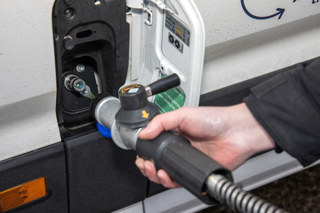Commercial Group has taken delivery of its first hydrogen hybrid van as it examines the technology’s potential to cut costs and carbon emissions for itself and other fleets.
The company is using the new van to make deliveries across Greater London as part of a three-year trial which forms part of the London Hydrogen Network Expansion (LHNE) project.
The scheme, which is being funded by the Government’s Technology Strategy Board, aims to extend the use of hydrogen-powered vehicles in London and the south east while simultaneously establishing a network of publicly-accessible hydrogen fuelling stations.
Simon Graham, environmental strategist at Commercial Group, said it is too early in the trial to know for sure whether the hydrogen-hybrid van will meet the requirements of its fleet.
He added: “The early feedback from our drivers over the past month has been good.
“As the van is a hybrid – and runs on diesel if the hydrogen runs out – there aren’t any range anxieties if the driver is not near a hydrogen refuelling station.
“Depending on the outcome of this trial, we’ll be able to formulate a strategy regarding our future use of hydrogen hybrid vehicles. The information will also be shared with other fleet users as part of the conditions of the scheme.”
Graham said Commercial Group was approached to participate in the LHNE project as a result of its success in driving down carbon emissions from its fleet using biodiesel.
The company provides a range of office services – from the fit-out of new premises to IT support – and operates a fleet of 20 Ford Transits that could be converted.
The hydrogen hybrid van is being used by Commercial Group’s office supplies division, which provides a next-day delivery service to customers.
Unlike the latest generation of hydrogen fuel cell vehicles, the hydrogen here is combusted in the engine.
Stephen Pegrum, project design engineer at Revolve Technologies which carried out the hydrogen-hybrid conversion on Commerical Group’s new van, said his company, which is a partner in the LHNE project, is being asked to do an increasing number of these conversions.
He said: “Basically, the diesel engines are adapted so that the fuel ignites the hydrogen in the engine’s combustion engine.
“By combining the two in this way, it increases the miles per gallon that are possible while lowering emissions.
“The van is still capable of driving as normal using diesel alone if it’s not near a hydrogen refuelling station.”
The LHNE initiative, which is being led by industrial gas provider Air Products, is upgrading the existing hydrogen fuelling station situated close to Heathrow Airport to a fast-fill 700 bar pressure system.
Manufacturers that have committed to producing hydrogen-powered vehicles have confirmed that they will require this level of pressure rather than 350 bar.
In addition, accessibility to the existing dual pressure fuelling station at Millbrook Proving Ground, in Bedfordshire, and the Transport for London (TFL) station, in Stratford, are expected to be increased for motorists.
The project is also creating a new fuelling station in London, the location of which is expected to be announced within the next month.
Diana Raine, European business manager hydrogen energy systems at Air Products, said more sites will be named across the city region later this year.
“We’re witnessing an appetite from the automotive manufacturers to produce hydrogen-powered vehicles – it’s been well documented that the first production line vehicles will arrive next year,” she added.
“As reducing carbon emissions increasingly climbs the political agenda, it’s becoming more widely acknowledged that hydrogen-powered vehicles are going to have an important role to play.
“We are delighted to provide the fuelling facilities that will enable Commercial Group to operate this new fleet, which will demonstrate first-hand how hydrogen vehicles can easily operate in the real world.
“The deployment of these vans is another important step for the LHNE project, which is bringing together all the components necessary to make hydrogen transport possible across London and the south east.”






















Jim - 25/03/2014 11:45
A great implementation to use the same engine for both fuels. For how long has this engine adaptation been known about - and what range/tank capacity is possible for the hydrogen ?